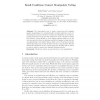Free Online Productivity Tools
i2Speak
i2Symbol
i2OCR
iTex2Img
iWeb2Print
iWeb2Shot
i2Type
iPdf2Split
iPdf2Merge
i2Bopomofo
i2Arabic
i2Style
i2Image
i2PDF
iLatex2Rtf
Sci2ools
115
Voted
FC
2005
Springer
2005
Springer
Small Coalitions Cannot Manipulate Voting
We demonstrate how to make voting protocols resistant against manipulation by computationally bounded malicious voters, by extending the previous results of Conitzer and Sandholm in several important directions: we use one-way functions to close a security loophole that allowed voting officials to exert disproportionate influence on the outcome and show that our hardness results hold against a large fraction of manipulating voters (rather than a single voter). These improvements address important concerns in the field of secure voting systems. We also discuss the limitations of the current approach, showing that it cannot be used to achieve certain very desirable hardness criteria. Keywords. Electronic voting, one-way functions, vote manipulation.
| Added | 27 Jun 2010 |
| Updated | 27 Jun 2010 |
| Type | Conference |
| Year | 2005 |
| Where | FC |
| Authors | Edith Elkind, Helger Lipmaa |
Comments (0)

